|
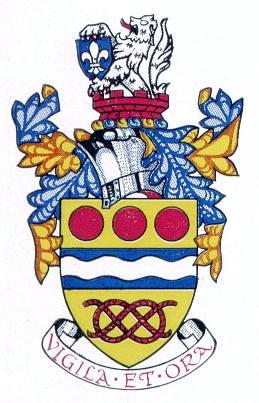
|
Bourne
Town
Council
INAUGURATED
1974 |
The origins of the town council date back to the late 19th century when Bourne was governed in its local affairs by vestry or parochial meetings with the courts of its two manors of Bourne and Bourne
Abbots still active and exercising rights over their respective properties. The Local Government Act of 1894 provided for the establishment of urban district councils and it was as a result of this legislation that local government as we know it today began.
Bourne Urban District Council came into being on 1st April 1899, formed by Local
Government Board Order No 38,377, with jurisdiction over an area that included the village of Twenty together with Dyke and Cawthorpe that had always been within the old parish of Bourne. The first chairman was Mr
John Baxter Shilcock (1899-1900), whose family were in business as millers and maltsters and owners of the Star Brewery that supplied many local public houses with their ale. He headed the council again in 1921-22 and other past chairmen have included Thomas William Mays, the father of the motor racing pioneer Raymond Mays, who was chairman four times in successive years from 1904 until 1908, Mrs Caroline Galletly who was the council's first woman chairman (1930-31) and her son Dr Alistair Galletly (1961-62).
|
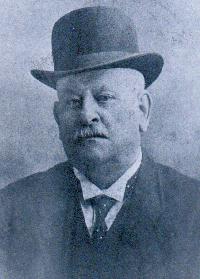 |
Mr
John Baxter Shilcock and Mrs Caroline Galletly,
two former chairmen of Bourne Urban District Council
|
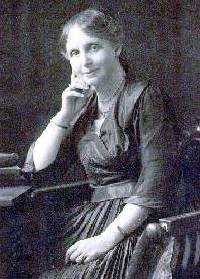 |
The council had a wide range of responsibilities including community services, public health and even the fire brigade. The success of the town through expansion was a particular aspect of its work and during the early years of the 20th century, one of their main aims was to attract light industry and their efforts met with some success and laid the foundations of the business community that we have today.
Housing was one of its major activities and the urban district council was responsible for the increase in council housing between the two world wars of the 20th century when the population of the town doubled. New streets were added to keep pace with the demand for accommodation and it was during this period that many council estates such as Recreation Road, Harrington Street, Queen's Road and Edinburgh Crescent were built.
The original council chamber was in the old Corn Exchange in Abbey Road but the offices were later moved to the Town Hall. The council was granted its own coat of arms on 23rd July 1953 in the archaic terms of the College of Arms:
Or, on a fess azure between in chief three torteaux and in base a Wake Knot gules, a bar wavy argent, and for the crest, on a wreath of the colours issuant from the battlements on a tower gules a demi-lion ermine holding between the paws an escutcheon azure charged with a fleur-de-lys
argent. The shield is a modification of the arms of the Wake family who were Lords of the Manor from 1166 until the 14th century and are not to be confused with Hereward the Wake, whose exploits are the subject of many fictional tales. The three red roundels in gold remain and the characteristic Wake knot is depicted in the base of the shield. The two red bars from the Wake arms are replaced by a single broad blue one charged with a navy white one, representing two waterways, the Bourne Eau and the Car Dyke. Above the shield is the closed helm granted to civic authorities and this is furnished with the twisted crestwreath and slashed oak or mantlings in the main colours of the arms, gold and blue.
The red battlements represent the castle, the ermine lion is from the arms of the Cecils who have owned the market rights in Bourne since 1564 and from which family came the first Lord Burghley, while the lion holds a shield of arms of the Digby family who once lived at the Red Hall. The motto included within a scroll at the base is
Vigila et Ora, or Watch and Pray, which is also used by Bourne Grammar and the Abbey Primary Schools.
A public subscription list was opened in 1953 to purchase suitable civic regalia for the council and a jewel incorporating the coat of arms was obtained together with a chain of office in 1955 to be worn by the chairman of the council on official occasions and a tapestry of the coat of arms was hung in the council chamber. Bourne Urban District Council continued to administer local affairs until April 1974 when it was disbanded under the local government re-organisation after a period of 75 years. The final meeting of the council was held in the Town Hall on 12th March 1974 when apart from dealing with routine matters of business, councillors heard from the various committee chairmen giving a resume of work done in the recent past and then members, together with their wives, husbands and officials, posed for a farewell photograph.
All urban authorities in England were replaced at this time by district councils and henceforth, Bourne's affairs came under the control of South Kesteven District Council based in Grantham but the town retained a parish council which, because of its historic status, was given special dispensation to become a town council with a chairman who is also the mayor and this authority took over the Coat of Arms and civic regalia. For a short time, the new council held its meetings at the Red Hall but it was later decided to hold them at Wake House where the district council had its offices and meetings continued there until 1993 when they were transferred to their current venue at the Town Hall.
A number of councillors have given long and dedicated service to the town but special mention must be made of husband and wife team,
the late Ray Cliffe (1925-2006) and Mrs Shirley Cliffe, who served for a total of sixty years between them. Both
were mayor twice, he in 1975-76 and 1991-92 and she in 1979-80 and 1997-98. Another stalwart
was Mrs Marjorie Clark (1919-2007), who served as a councillor for more than 40 years and was chairman of the old urban district council in 1970-71 shortly before it disbanded. She
was also mayor twice under the new authority, from 1984-85 and again from 1999-2000 when she fulfilled the office of the town's first citizen at the remarkable age of 80.
The present town council has 15 members and retains the old committee structure but administers a budget of less than £100,000 a year. It does have an input into planning applications and other matters under consideration by the district and county councils but is in effect a token authority with few powers apart from the control of the cemetery, the town's allotments and the Christmas lights, but is regularly consulted on the choice of street names on new developments. Over the years however, some councillors have gone on to serve with distinction on the district and county councils.
|
Introduction to Bourne Town Council and its
Committees
(reproduced from the council's own newsletter - Issue 1/Winter 2004) |
|
The town council, which meets nominally at six-weekly intervals,
is made up of 15 councillors. The parish is divided into two areas,
East and West wards, with seven representing the East ward and eight
representing the West ward. Each year, in May, one of the number is
elected as chairman of the council, otherwise known as the Town
Mayor.
The council is served by the Town Clerk who carries out the day to
day duties of the Council and implements its decisions ensuring that
all the legal requirements are complied with by the council.
There are three Standing Committees of the council which report to
it and make recommendations for its approval. At its annual meeting,
the council appoints the chairmen of the three committees, which
are: Highways & Planning, Amenities and Finance & General Purposes.
The responsibilities of each are as follows:
Highways & Planning ; As its name implies, this deals with
planning applications and meets twice within the council's
six-weekly cycle to ensure that the council influences decisions by
South Kesteven District Council (SKDC). Bourne is a busy town and
the committee processes approximately 200 planning applications a
year. Bourne Town Council has a right of involvement in the
development of Bourne, Cawthorpe, Dyke and Twenty, in terms of Town
& Country Planning. As the elected body of the community, the
council is consulted over longer-term development plans as well as
individual planning applications.
The Planning Authority (SKDC) must take into consideration any
observations made and although they are in no way binding, on the
ultimate decision made by the Planning Authority, they are a valued
indication of local feeling.
The committee also deals with road and footpath matters together
with referrals on questions of public health.
Amenities: This committee is responsible for the
operation and maintenance of the town cemetery, the council's
allotments and the town centre Christmas lights displays.
The committee looks at the amenities the council owns or has control
over and makes recommendations regarding provisions for the future
as well as the continuing maintenance. It also makes recommendations
on costs and charges involved and has a budget to fulfil all of
these tasks.
Finance &. General Purposes: This committee deals with
anything not dealt with in the Planning and Amenities committees,
including matters of administration, staffing, grants and donations.
This committee sets the budget for the forthcoming year and
determines the Bourne portion of the council tax, which enables the
council to do what it can on your behalf.
All three committees make use of working parties (advisory groups)
which make recommendations on particular issues.
Meetings of the town council normally take
place on a Tuesday at 7.30 pm and are held at the Town Hall. The
meetings of the Highways & Planning committee however are held on
the same night as the full council, meetings which starts at 6.45 pm
and are followed by a Public Open Forum at 7.30 pm (maximum of 30
minutes) with the full council meeting at 8 pm, or at the end of the
public forum, whichever is the sooner. Any person wishing to speak
must be present at the start of the forum to ensure they are are
given the opportunity to put their question. An individual may ask
no more than two questions during a forum session. |
|
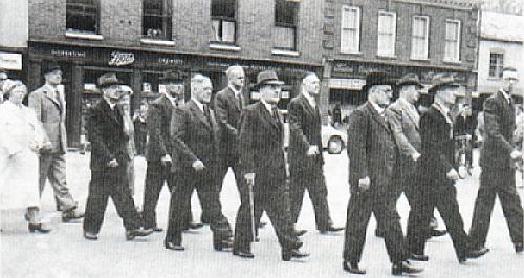 |
|
Members of Bourne Urban
District Council parading through the Market Place at Bourne to
mark the Coronation of Queen Elizabeth II on Tuesday 2nd June
1953. Those in the picture are (from the left) Councillors Mrs E
Tipler, T L Lyall, Mrs E D Cooke MBE, H Scotney, H Bridgeman, F
Key (chairman of South Kesteven District Council), L R W Day and J
Burchnell, Mr J J Godber MBE (clerk to SKDC), Mr F Wherry
(chairman of Bourne magistrates and former chairman of the
council), Councillors H Hudson and J Grummitt (chairman), and Mr D
Reeson (clerk to the council). |
|
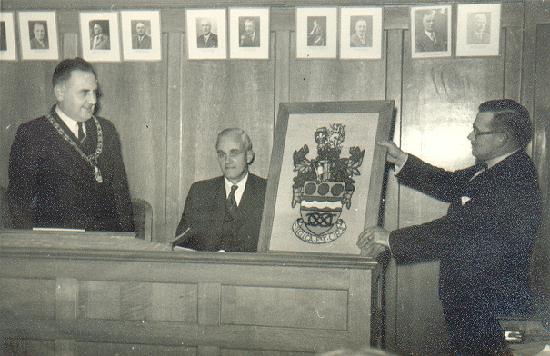 |
|
A tapestry of Bourne
Urban District Council's Coat of Arms that had been worked by Mrs
Joan Jones, wife of Councillor Tom Jones, was handed over by him
to the chairman, Councillor Jack Burchnell, in 1968. The
vice-chairman, Councillor Leslie Day, can be seen in the centre. The
tapestry hung in the council chamber at Wake House until the
council was disbanded in 1974 and it can now be seen on display at
the Heritage Centre in Baldock's Mill.
See also Tom Jones |
|
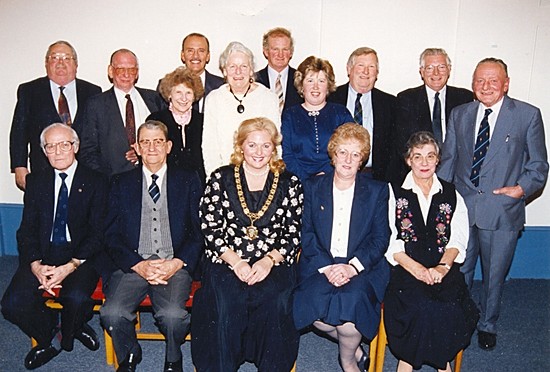 |
|
THE TOWN COUNCIL IN 1994
In the picture are from left to right (back row) Peter
Garner, Stan Pease, Marjorie Clark, John Kirkman, Mary Parker,
Brian Sherwin, Linda Neal, John Smith, Don Fisher and Ray Cliffe
and (seated) John Wright, Alan Jones, Lesley Patrick, then Mayor
of Bourne, Mary Redshaw, clerk to the council, and Shirley Cliffe. |
|
THE TOWN COUNCIL IN 2000
Mrs Mary Redshaw served as clerk to Bourne Town Council from 1989
until 2000, retiring on June 20th that year when councillors
gathered to acknowledge her work. She is seen here with the Mayor,
Councillor John Kirkman, on the steps of the Town Hall after her
last council meeting receiving gifts and a bouquet of flowers to
mark her 11 years in office. Also in the picture are (from the
back), Councillors Mike Holden and Guy Cudmore, Don Fisher and
John Smith, Mrs Norma Wolley and Mrs Pet Moisey, Ray Cliffe, Alan
Jones and Trevor Holmes. Mrs Redshaw was succeeded by Mrs Nelly
Jacobs who remained clerk until 2015. |
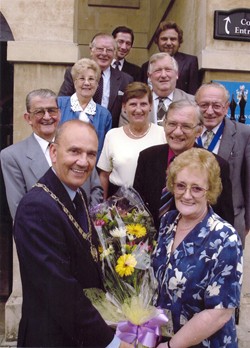 |
REVISED AUGUST 2016
See
also Local government
The Town Hall
The Vestry Hall
When Bourne was clean and smart
Council chairmen &
mayors of
Bourne since 1899

Go to:
Main Index
|






